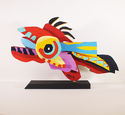
19th, 20th & 21st Century Fine Prints
707-546-7352 · fax 707-546-7924 · web: www.annexgalleries.com · email: artannex@aol.com
Christiaan Karl Appel Biography
Christiaan Karl Appel
Dutch
1921–2006
Biography
Painter, sculptor, muralist, and poet Karel Appel was born Christiaan Karel Appel on April 25, 1921, one of four sons born to Jan Appel and Johanna Chevalier. An early interest in art and the encouragement and financial backing of his uncle, painter Karel Chevalier, led to his enrollment at the Rijksakademie van Beeldende (Amsterdam) in 1940 - despite his parents' disapproval. His enrollment served another purpose: to avoid conscription into the German army as a weapons builder for the Nazis.
Following the war Appel began working in sculpture, with particular focus on assemblage of found or used objects which he would then paint in bold, saturated colors. He participated in his first show in Groningen in 1946, and, along with peers Corneille, Constant, Asger Jorn, and Joseph Noiret, began forming the post-war avant-garde artists' group, CoBra. Their first group show was held in 1949 at the Stedelijk Museum in Amsterdam, which proved to be controversial. The negative reaction by the Dutch audience prompted Appel to relocate to Paris, finding more freedom of expression in the established art hub in 1950. There, he set up his studio and began traveling on sketch trips, visiting Mexico, Brazil, New York City, and Florence. He held his first American exhibition at the Martha Jackson Gallery in 1954, and his work "Child and Beast II" was included in the major Museum of Modern Art exhibition, "The New Decade" in 1955.
While Appel found success internationally, it wasn't until the 1990s that his work was accepted and celebrated in the Netherlands. He was invited to exhibit in Amsterdam and Brussels and the CoBra Museum held several shows highlighting his work. Around this time he established the Karel Appel Foundation to preserve his work and his innovation during his time with CoBra; today, he is considered the most internationally recognized CoBra founders. Appel died of heart failure on May 3, 2006.
Appel's work is held in the collections of the Museum de Fundatie, Zwolle, the Netherlands; Aboa Vetus and Ars Nova, Turku, Finland; Art Gallery of Hamilton, Ontario, Canada; Rijksmuseum, the Netherlands; the Phillips Collection, Washington, D.C.; Gallery Delaive, Amsterdam; Frances Lehman Loeb Art Center, Poughkeepsie, New York; Art Museum of Southeast Texas, Beaumont, among others.
A full list of Appel's extensive exhibitions can be found here.


